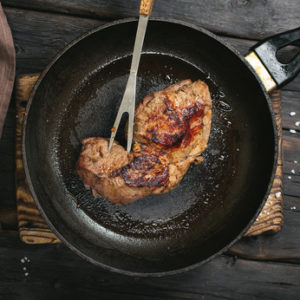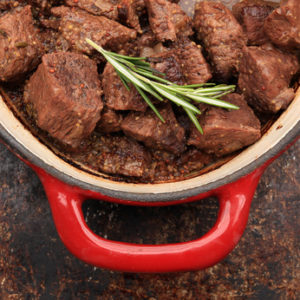Whether you are foodie, seasoned home cook, celebrity chef, paleo dieter, or a health & environmentally conscious consumer, this is information that you need. This is particularly pertinent information for customers who are trying grass-fed beef for the first time. Old rules do not apply. We consider it a true CRIME to overcook Grass-Fed Beef!!
Hopefully, you will pass the test, graduate with honors, and have some fabulous meat eating experiences along the way.
First and foremost, it is vital to be aware of how the 100% Grass-fed Wagyu Beef, offered at Pasture Prime, varies from the conventional, industrially raised, grain fed, super market beef, with which we are all familiar.
- Grain-fed beef is insulated by fat which takes longer to cook
- Grass-fed is much leaner, not insulated and therefore cooks much faster, about 30% more rapidly.
- There is much more variation in the size of cuts with grass fed animals, (not being raised in a feedlot to uniform sizes).
- These variable size cuts will not cook in the same manner as those with which you are most familiar, and must be dealt with individually.
- Grass-fed beef appears much more red or pink when fully cooked, even when cooked to the same temperature.
- All these differences make use of a meat thermometer mandatory, for desired results.

Now that you are up on the differences, here is how to deal with them when cooking the Grass Fed Wagyu from Pasture Prime Family Farm.
5 Basic Principles:
- Put Away your Timer – use visual cues
- Use a good Meat Thermometer, preferably digital (Thermapen is our favorite!)
- TURN DOWN THE HEAT – If you are using one of the slow cook methods.
- Learn proper cooking methods for each individual cuts (see below)
- Ease up on seasonings which mask the unique, full beef flavor of our meats. Enjoy what your beef is supposed to taste like. (All you need are salt, pepper and possibly some simple herbs.)
Cooking is defined as the application of heat to food. However, all HEAT is not created equal.
As we will explain, there is a big difference between Moist heat and Dry heat.
Your next lesson is on how to execute each method and which cuts are best cooked using each technique:
COOKING TECHNIQUES:
ROASTING & BAKING:

How: surround food with dry hot air (300 to 500 degrees), this heats the surface, evaporates moisture and allows for browning. By extending cook times roasted or baked dishes develop rich flavor.
Cuts: large cuts of meat; whole tenderloins, pork butts, leg of lamb, whole chicken

SEARING, SAUTEING, & PAN FRYING:
How: meats are added to a very hot pre-heated pan, with our without added fat, this facilitates quick cooking on more tender cuts, allowing for development of brown crust.
For best results, don’t crowd pan which reduces pan’s temperature limiting browning, cause loss of moisture and lengthen cook times.
Cuts: uniform sizes of steaks, chops, chicken breasts, burgers, hot dogs.
BRAISING, STEWING or BOILING:
 How: as you can see, moist and dry heat have very different effects on food. However, when combining both these methods, something magical happens.
How: as you can see, moist and dry heat have very different effects on food. However, when combining both these methods, something magical happens.
Begin by searing or pan frying and then adding liquid (water, wine, broth or stock) and simmering (oven, stove-top, slow cooker) until meats are cooked through and tender. Now you have achieved the best of both worlds; browning flavors from dry heat and succulence that only low, moist heat can coax out of meats.
Cuts: any tougher cut, roasts from the round, shanks, brisket. Muscles that do lots of work develop connective tissue called collagen which can make meat tough. The job during cooking is to break down that collagen and making the meat more tender with the proper cooking method.
Once you learn which cooking method works best for each cut, you can routinely expect superior results.
You should be ready for your PhD (Pretty Healthy Dinner) soon!
RECOMMENDED INTERNAL TEMPERATURES FOR COOKED MEATS:
from Shannon Hayes The Grassfed Gourmet Cookbook
| MEAT | SUGGESTED INTERNAL TEMP (F) | USDA RECOMMENDED INTERNAL TEMP (F) |
| Beef, Bison, and Venison | 120°-165° | 140°-170° |
| Veal | 125°-155° | 150°-170° |
| Lamb and Goat | 120-145° | 140-170° |
| Pork | 145°-165° | 170° |
| Chicken | 160°-165° | 180° |
| Turkey (unstuffed) | 160°-165° | 180° |
| Goose | 170° | 180° |
| Duck | 160°-170° | 180° |
| Rabbit | 160° | 160° |






 While bone broth has been a go-to ingredient for thousands of years, the popularity of the Paleo Diet, which emphasizes the consumption of foods that would have been available to humans during the Paleolithic era (things like grass-fed meat, fish, and fresh fruits and veggies), has helped propel bone broth into the spotlight to enjoy some long overdue praise and attention. We’ve stepped up to
While bone broth has been a go-to ingredient for thousands of years, the popularity of the Paleo Diet, which emphasizes the consumption of foods that would have been available to humans during the Paleolithic era (things like grass-fed meat, fish, and fresh fruits and veggies), has helped propel bone broth into the spotlight to enjoy some long overdue praise and attention. We’ve stepped up to 






























